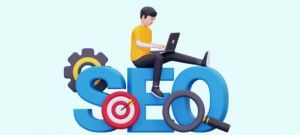Digital marketing is now very popular around the world. The demand for digital marketers is very high in the market. Whether you’re a beginner or someone experienced in the field of digital marketing, interviews can be very challenging without proper preparation.
In this blog, we will get to know 30 most commonly asked digital marketing interview questions and their sample answers which will help us in our next interview.
Top 30 Digital Marketing Interview Questions and Answers
1. What is digital marketing?
Answer: In Digital Marketing, we use different digital channels like Instagram, Facebook, Youtube, Twitter, etc. to market our products online,so that we can boost our brand awareness and achieve our marketing goals.
Digital Marketing requires all the marketing efforts that we are going to put on internet or digital devices and digital marketing has secured a very good place in this modern business world. So if we also want to make some space for us or for our businesses. Then we have to keep 2 things in mind:
- We should know how to communicate well.
- We should know how to express our thoughts and emotions.
And we can express it through “Content Writing”
Simple formula to become a “Digital Marketer” is-
Content creation (text, photo/graphics, video, audio) + Tools + Data Analysis = Digital Marketer
And skills needed for this:
- Write in English
- Creativity &
- Tech- friendly
2. Why do companies prefer digital marketing over traditional marketing?
Answer:
Because digital marketing helps us to do better targeting, low our costs, measure the results, and we will get faster feedback. It’s also easier to reach a global audience instantlyas compared to traditional marketing.
3. What are the main types of digital marketing?
Answer:
The core digital marketing strategies are:
- Search Engine Optimization (SEO)
- Pay-Per-Click Advertising (PPC)
- Content Marketing
- Social Media Marketing
- Email Marketing
- Affiliate Marketing
- Influencer Marketing
- Mobile Marketing
4. What are the benefits and challenges of digital marketing?
Benefits of digital marketing
1.Cost-effective Marketing:
Unlike following traditional methods such as TV, newspaper, radio, billboards etc. We can use digital marketing which is much more cost-effective and we can advertise on multiple platforms like Facebook, Instagram, Twitter, Google etc with a very low budget and still we can reach a large number of potential customers/ target audience.
This method is very useful for small businesses and startups that may not have a huge budget.
- World-wide Reach:
Instead of advertising on newspapers or TV, we can reach a large number of customers with the help of Digital Marketing and show our products/ services to them by investing a small budget. And it is not that much difficult to have our presence on the internet and maintain it because nowadays everyone is active on multiple social media platforms. And by having our presence on the internet we can secure an international position too.
And once our business is set up on the internet, many doors will open for us and we will be able to earn more money from it.
- Specific Targeting:
With the help of digital marketing, we can choose our exact target audience based on their age, gender, location, areas of interests etc.
By doing this, we will get a perfect audience who can show great interest in our products and services.
And this will start giving us higher returns.
- Measurable Outcomes/ Achievements:
Just as we move forward step by step, with the help of Digital Marketing, we can measure each and every step accordingly.
This will help us to understand what is working, what is not working, what needs improvement, which things are getting better response from the audience and whether our return on investment (ROI) are increasing or not.
This step is very important because it gives us the actual data and after analyzing it we can use an even better strategy to grow.
- Higher Conversion Rate:
With the help of digital marketing, we can show content or ads to our audience and now there is a high chance that they will like our products and services more, and there is also a high possibility that they will convert quickly.
This step is also very important because in this our audience converts into our customers.
Challenges in digital marketing
- Very High Competition:
In the past few years, Digital Marketing has become very popular and now, from the smallest brands to the biggest ones, everyone is following the rules of Digital Marketing to promote their products & services and to become well- known around the world. Because of this, the level of competition has increased in the field of Digital Marketing.
But if we want to stand out from the crowd. It is not as difficult as we think.
We just need to showcase our products & services in a very creative and unique way so that people get attracted quickly, start trusting us and become loyal customers.
- Changing Algorithms and Trends:
Nowadays, social media app algorithms and market trends keep changing. For example, something that works today might not work tomorrow. So, If we want our products and services to succeed in the market, we need to adapt according to these changes. And if we fall behind in this, we should create a good strategy and move forward step by step with the market trends.
But what if our views are decreasing and fewer customers are reaching us after adapting according to the market changes?
In that case, there’s no need to panic. We just need to create the right strategy and follow it strictly.
- Creating Regular Content:
It is very important to create content and post it regularly in digital marketing. If we stop posting content in between, we might lose the customers we gained through digital marketing. And once we lose them, it becomes very difficult to gain them back. That’s why we should create content regularly.
Yes, it can be a bit difficult to decide what to post regularly, but if we have the right mindset and we make a content calendar for every month, it will help us to stay consistent. This way, we’ll keep gaining customers and will not lose any.
- Getting followers and likes:
If we are completely new to the field of digital marketing and we want to grow our likes and followers organically without spending money, then we need to work with a lot of patience. If we don’t stay patient, we won’t be successful and might leave the work halfway. But if we stay patient and work with the right mindset and strategy, then in a short time, we can build a strong and organic image on online platforms, and people will start recognizing us easily.
The most important point we need to keep in our mind is that- we shouldn’t panic by seeing low followers or likes. We must keep our vision high, use smart strategies, and always think from the audience’s point of view. People don’t really care about what we want to sell, they care what they receive. And if we are able to give them what they truly want, they will show a lot more interest in our products and services.
- Handling Negative Comments or Reviews:
When we post something online, there will always be some people who will give us negative comments and reviews. But we should not get scared by them, and should not ignore them. Instead, we should respond to them promptly.
If any customer doesn’t like or does not get satisfied with our service, we should immediately apologize to them. And if our product hasn’t reached them properly, we should offer a replacement. This will help to build trust in them for us, they’ll remain loyal customers, and we won’t lose them.
5. How AI is helpful in digital Marketing?
AI has secured a very strong position for itself in the market, especially in the field of digital marketing. Like, we all have noticed that if we are looking for something for eg- shoes on myntra and we add it in our cart. After that, we’ll start seeing ads for those shoes on all our social media accounts. Whether it’s Facebook, Instagram, or Google, those shoes will follow us everywhere. This happens because of AI-based retargeting.
When we visit a transactional website, we can ask basic questions directly through a chatbot powered by AI.
Even platforms like WhatsApp and Instagram have introduced updates such as Meta AI, which helps to improve customer experience.
6. What is the difference between inbound and outbound marketing?
Push (Outbound Marketing) and Pull (Inbound Marketing). Push marketing reaches out to customers directly (like advertising to them), and it is mainly used for demand generation. It often results in higher conversion rates, but also leads to cash burn and focuses on getting unlimited customers. Around 90% of marketing is push-based. In contrast, Pull marketing attracts customers to come towards the product or service. It is cost-effective and helps in sustaining the business, though its major limitation is a limited customer base. If a business lacks funds, it should rely on the Pull method.
7. What do buyer’s do before making a purchase?
Answer:
Buyers go from three stages which are:
- Awareness (problem identification)
- Consideration (solution research)
- Decision (choosing a product/service)
8. What is a landing page?
Answer:
A landing page is a single – purpose web page focused on one goal- usually converting visitors into customers. It’s often used for ads, email campaigns, or product launches.
Examples:
- Free trial signups
- Ebook downloads
- Webinar registrations
- Limited-time offers
Pros:
- Focused message
- A/B testing
- Measures performance clearly
Cons:
- Needs skilled design and copy
- High bounce rates if not optimized
- Time-consuming setup
9. What is a conversion rate?
Answer:
It is the total number of visitors who complete a particular action, like signing up or purchasing something, out of the total visitors to a page.
Formula:
Conversions ÷ Total Visitors × 100
10. What is a CTA (Call-To-Action)?
Answer:
A CTA encourages users to take a specific action, such as “Buy Now,” “Subscribe,” or “Learn More” that is given on any informational or transactional website.
11. How do you measure digital marketing success?
Answer:
By tracking:
- Website traffic
- Conversion rates
- Return on Ad Spend (ROAS)
- Cost per lead
- Bounce rate
- Engagement metrics (likes, shares, comments)
12. What tools do you use for digital marketing?
Answer:
- Google Analytics
- Google Ads
- Meta Ads Manager
- SEMrush / Ahrefs
- Canva
- Mailchimp / HubSpot
- Hootsuite / Buffer
- Google Search Console
13. What is the role of a digital marketer?
Answer:
Simple formula to become a “Digital Marketer” is-
Content creation (text, photo/graphics, video, audio) + Tools + Data Analysis = Digital Marketer
14. What is lead generation in digital marketing?
Answer:
By lead generation we can know who is showing interest in our products and services.
15. What is ROI in digital marketing?
Answer:
ROI (Return on Investment) which means what we are getting after investing our money through digital marketing.
Formula:
(Revenue – Cost) ÷ Cost × 100
16. What is A/B testing?
Answer:
In A/B testing we compare two versions of the same topic (e.g., what is digital marketing on two different web pages) to see which performs better.
17. What is the bounce rate?
Answer:
Bounce rate is the percentage of visitors who leave a website immediately after viewing only one page within 2-3 seconds. A high bounce rate may indicate poor content or bad UX.
18. What is customer segmentation?
Answer:
It means to have our own target audience based on demographics, behavior, or interests to create more personalized and effective messages, content or ads.
19. What is a digital marketing funnel?
Answer:
It typically includes:
- Awareness
- Interest
- Consideration
- Action
- Loyalty
20. How do you handle a failed campaign?
Answer:
Analyze the data to identify what went wrong—targeting, messaging, platform, or timing. Learn from the insights, A/B test, and revise the strategy according to that.
21. What trends do you see shaping the future of digital marketing?
Answer:
- AI and automation in personalization
- Voice search optimization
- Short-form video content
- First-party data usage
- Influencer + micro-influencer marketing




